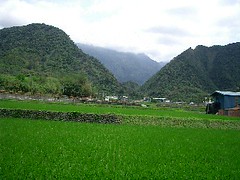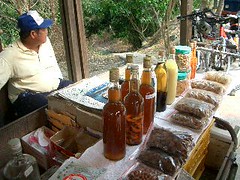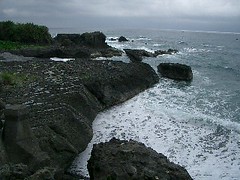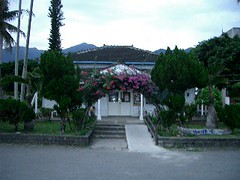Head down Heping East Road past the the Liuzhangli MRT station at the corner of Keelung Rd. and Heping. Turn left onto Jiaxing St. at the first light after the MRT station. Ride past Bobwundaye and continue on Jiaxing past the police station until you see 711. Turn right onto Chongde St. and ride past some interesting old brick shops and houses in the heart of Liuzhangli. You will pass the local Earth God's temple. He is particularly efficacious according to the friendly owner of the country store across the street. This store, incidentally, was built by the current owner's mother-in-law who hauled bricks down from Fudekeng after American air raids during World War II.
Keep to the left to stay on Chongde and you will pass through a ramshackle shanty town of the kind that used to be all over Taipei. The road will begin to ascend gently and you will soon find yourself in Taipei City's public cemetery. The first section is the Muslim cemetery in which Bai Chongxi, the famous Republican Muslim general from Guangxi, is buried. A little further on, you can take a steep left and visit the White Terror Memorial.
Stay on Chongde for several km. After the first climb, the grade gets much easier even though you are steadily climbing. You will eventually come to a junction. Yanjiuyuan Rd. on the left will take you to Nangang. Stay on Chongde for another five minutes or so and you will see an abandoned truck weighing station. Turn right here and head downhill to Muzha.
At the bottom of the hill is Muzha Rd. From here you have many options for longer rides:
Pingxi/Pinglin (via Shiding).
Cross the bridge toward Taipei Zoo and turn left onto Xinguang Rd. Stay on Xinguang Rd. as it loops under the freeway and continue on straight down Wenshan Rd until it ends. Now cross the river and you will be on Beishen Rd. having bypassed unpleasant downtown Shenkeng. From here you can continue onto to Pingxi and Pinglin via Shiding. It is also possible to take a small access road over the hills to Nangang and then loop back to the cemetery on Yanjiuyuan Rd. (see above).
Zhinangong Loop
If I am just out for quick three hour workout, this is the route I usually take. Turn right on Muzha Rd, cross the freeway exit, and continue on until you reach Jungong Rd. Cross to the other side of Muzha Rd. and look for the entrance to the Jingmei River bikepath. The second bridge is Zhinan Rd. Cross the bridge and follow Zhinan Rd. to Zhengda's main gate. Turn left at the bus station and then right onto Wanshou Rd. Climb up Wanshou Rd. to the Zhinan Temple parking lot. Stop for a bit of a rest and a popsicle at the first vendor on the right in the covered market. Carry your bike into the covered market. After the first few shops, you can see up the hill on the left. Carry your bike up the steps on the left (this a bit of a workout) until you reach a concrete path. Turn left and head up the slick trail which will loop up onto the ridge. Stay on the trail veering to the right (nice view of Zhinan Temple, one of Taiwan's most important Taoist temples, on the left) until you reach a second parking lot. Follow the road out the back of the parking lot. About .5 km later you will see a dirt trail on the left. Off-road enthusiasts of all levels will enjoy this single track that is nearly flat and takes about 10 minutes if you can stay on your bike. This trail is much flatter after the first 1/4 but is very wet and slippery after rains as it is one the wet side on the mountain. You will come out on Zhinan Road on the other side. Head down hill to return to the Zhengda area, go straight to Maokong, or head over the hills on Zhinan Rd. to Shenkeng's Wenshan Rd. (See above).
If you don't like off-road riding, just continue on and you will run into Zhinan Rd. a little further down the hill from the off road trail's exit. Turn right and head down the hill back to the Zhengda campus.
Back to Gongguan via bike paths
Get back on the Jingmei River bike path on the far side of the Jingmei River. The path is still under construction as of this riding, but there is another alternative walkway/bike path on top of the river wall. Switch to this after about 1.5 km when the construction gets heavy. Stay on top of the dike until you get to the bridge at Baoqiao Rd. Cross under the bridge and follow the river on Xinhai Rd. Section 7 until you hit Muzha Rd. Turn left for just a few blocks and make another left onto Lane 70 across from Yongjian Elementary School. Follow Lane 70 and you will quickly find another bike path/walkway on the dike. Follow this until you come out on Muzha Rd. again and then stay on Muzha Rd. until you get to the old Jingmei Bridge where you can access the Riverside Park bike paths. Take these to Gongguan or Guting.
Shorter Return to Heping East Rd. Section 3/Bobwundaye
If you are doing the graveyard as one of your first rides, you may be too tired to do the Zhinan Temple ride. If so, turn right onto Jungong Road and follow it up to the Zhuangjing Tunnel. Go through the tunnel and follow Wolong St. down the hill. Stay to the right and you will be on Heping E. Rd. Section 3. If you are heading to Bob's for a few well-deserved cold ones, a more pleasant way is to turn left off Heping on Lane 463 at Linguang MRT Station. Stay on Lane 463 keeping to the left and continue on until you run into Chongde St. right near the temple. Stay on Chongde until you see the 711 at the corner of Jiaxing St. Turn left onto Jiaxing St. and you will see Bob's blue sign on your right after you pass the police station.
I dislike riding through the Zhuangjing Tunnel (dangerous and polluted). Instead, I usually take the last left before the tunnel and go straight up the hill. This road connects up with Wolong St. on the other side of the tunnel.
Climbing Tips
Taiwan has some of the world's steepest mountains. That means it is nearly impossible to avoid climbing hills if you want to go anywhere nice on your bicycle. Here are a few tips that help me:
- Use toe clips or lock-in riding shoes
- Make sure your seat is not too low--you need to extend properly
- Try to breathe deeply rather than panting
- Relax your upper body--a tense chest and straining arms aren't going to help
- Focus on short-distance goals rather than the 7km you need to grind out. I often focus on a telephone pole or sign 200 or 300 meters away as a target
- Zig-zag if the grade is really steep
- Try not stay in your granny gears on medium grades. You just end up flailing about and wasting energy
- Remember that the first climb always hurts the most! You will feel much stronger on the second of third climb of the day. Get over the hump!
- If you ride regularly, you will be amazed at how fast what once seemed to be impossible hills now seem easy. I walked my bike most of the way up the first hill on this ride and was quite sure I would never want to do something so painful again. Fight through those feelings. It will be much easier next time!








